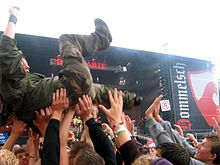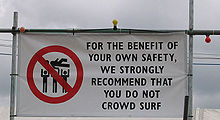- Crowd surfing
-
 A vocalist crowd surfing at the Alimas Carnival, Maldives.
A vocalist crowd surfing at the Alimas Carnival, Maldives.
Crowd surfing is the process in which a person is passed overhead from person to person during a concert, transferring the person from one part of the venue to another. The "crowd surfer" is passed above everyone's heads, with everyone's hands supporting the person's weight. At most concerts and festivals the crowd surfer will be passed towards a barrier in front of the stage by the crowd, where they will be pulled off and put onto their feet by the security stewards. Then, they will be sent back to the side or rear of the crowd at the end of the barrier or they may be ejected from the venue (depending on the policy enforced).
Crowd surfing generally occurs only towards the front of an audience where the crowd is dense enough to support a person's body. It is most popular at metal, punk, rock and indie concerts.
In order to get above everyone's heads, a person can be given a boost, in which one person picks up another to launch them over the people's heads, or they can stage dive.
This has been known to happen to unwilling participants who have been boosted up by others by surprise.
Contents
Origins
Fans have reported that Peter Gabriel crowd surfed at concerts as early as 1982 during performances of "Lay Your Hands on Me". The first official media release that depicts Gabriel crowd surfing was POV, a live concert video released in 1990 and produced by Martin Scorsese.[1] In more recent times, members of Gypsy-Punk band Gogol Bordello have taken to crowd surfing while riding a bass drum at live shows, as seen on the album cover of live at Axis Mundi.
Dangers of crowd surfing
 Crowd surfing at Parkpop, 2006-06-25.
Crowd surfing at Parkpop, 2006-06-25.
In 2000, at the Roskilde Festival, nine people died and several were wounded because they were trampled during a Pearl Jam concert.[2] Since then, crowd surfing has been made illegal at most festivals and concerts in Europe, and patrons can, in theory, be ejected from the venue for partaking in the act. This is usually written on the small-print of the tickets.
Supporters of crowd surfing say that by standing in the mosh pit, concert-goers should expect such behavior as part of a rock show and by standing more towards the side or rear of the venue they can easily avoid such behavior. They also say that serious injuries caused by crowd surfing are extremely rare. It is true that the majority of injuries caused by crowd surfing are only mild bruising, which occurs in any mosh pit without crowd surfing. Supporters will also argue that most crowd surfers are considerate and will wear soft shoes such as trainers, and refrain from wearing jackets in order to minimize injuries, and that it is common mosh pit etiquette to pick up anyone who has fallen over.
At larger events, such as festivals, crowd surfing can be used as a means of transporting individuals out of the crowd. On occasion, individuals may wish to leave the event because of any given reason, but there can be too many people bringing other people in. Therefore, some people use crowd surfing as a means to get out. Those facing the stage are often unaware of crowd surfers heading towards it and it is not uncommon for audience members to be kicked or otherwise hit in the back of the head. Opponents of crowd surfing reject these claims, claiming that it is inappropriate for crowd surfers, stagedivers and moshers to dominate the most attractive area of the audience (directly in front of the stage) with the threat of (accidental) violence forcing people who do not want to get injured to stand at the back or to the side, which are much less attractive locations. Opponents argue that all visitors pay the same price for admission and are entitled to experience the concert without risking to get kicked in the face or crushed by crowd surfers.
Crowd surfers also risk having personal items such as wallets or mobile phones stolen, or their shoes or clothes removed and thrown into inconvenient locations. This is known as "mosh-lobbing", usually done by audience members or even performers who see crowd surfing as a pointless activity.
In December 2004 when the Beastie Boys performed at the MEN arena in Manchester, England, Ad Rock stopped partway through a song to warn the crowds to stop surfing as somebody had been injured, following up the discouragement with "that shit is so old" and telling them to "save that shit for the MTV music awards".
See also
References
- ^ http://bilclarke.blogspot.com/2008/09/first-recorded-instance-of-crowd.html
- ^ Kerrin Linde and Reuters. "Pearl Jam: Lives could have been saved at concert". CNN.com. July 26, 2000.
External links
Categories:- Crowds
- Musical culture
Wikimedia Foundation. 2010.



